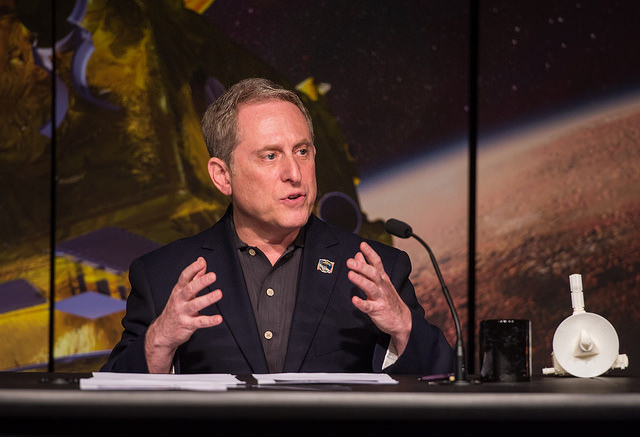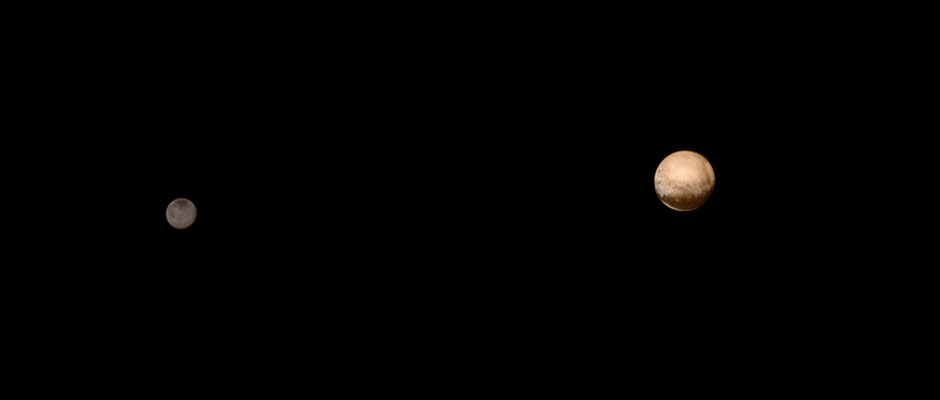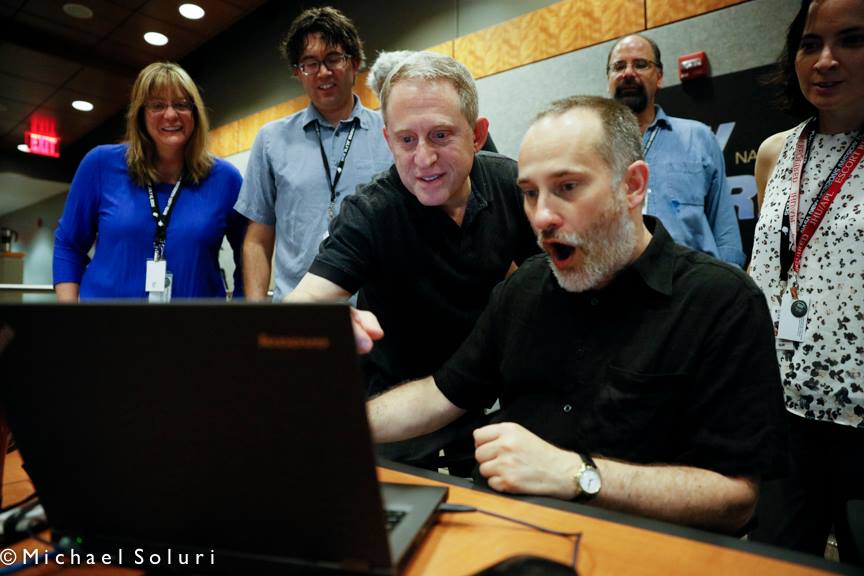
July is a month of rich rewards for Alan Stern, the scientist who shepherded the New Horizons spacecraft from the drawing board to Pluto, and the payoff will be sweet.
New Horizons comes closest to Pluto at 7:49:57 a.m. EDT (1149:57 GMT) on Tuesday, July 14, but data from the spacecraft is already telling Stern’s team about its composition and surface textures. Pluto’s largest moon Charon, long relegated as an also-ran in the imaginations of most scientists, is also finally coming into focus.
Pluto has lurked at the frontier of the solar system since its ancient beginnings, but the icy world entered human consciousness 85 years ago, when astronomy Clyde Tombaugh discovered it drifting across a star field.
Tombaugh found Pluto more than 30 times farther from the sun than the Earth at what scientists then believed was the very edge of the solar system. In a way, Pluto’s discovery was ahead of its time.
Now we know Pluto is part of a family of little worlds in a ring around the sun known as the Kuiper Belt. Farther still lies the Oort Cloud, the source of long-period comets that come whizzing by the sun.
NASA’s two Voyager robot explorers completed the “Grand Tour” of the solar system in 1989, when Voyager 2 zipped by Neptune, setting the bounds of humanity’s frontier at the time.
Tuesday’s encounter with Pluto will move the fence again, establishing a new record for civilization’s farthest reach.
After fleeting visits with Jupiter, Saturn, Uranus and Neptune, the Voyagers are still going, thanks to the endurance of their plutonium power sources, but their days of exploring new worlds have passed. Their main job now is probing the complex boundaries separating the solar system from interstellar space.
There was some talk of redirecting the Voyager 1 mission to visit Pluto, but managers opted put the probe on a trajectory to collect more data on Saturn’s moon Titan, observations Voyager 1 would have given up if it went to Pluto.

The bypass of Pluto — along with new discoveries of Pluto’s atmosphere and the Hubble Space Telescope’s first attempt to map the distant world — left an appetite to see it up close.
Stern was at the forefront of a more than decade-long movement to put Pluto in NASA’s crosshairs, overcoming cost and technical worries after interventions from supporters and politicians kept the initiative going. Then a panel of researchers in charge of ranking priorities for NASA’s spending on solar system science made Pluto one of its top goals for the 2000s.
NASA considered several mission proposals, eventually settling on Stern’s concept in 2001. The $720 million New Horizons mission launched from Cape Canaveral in January 2006, becoming the fastest spacecraft to ever depart Earth.
Stern, who also had a stint as head of NASA’s science division in 2007 and 2008, spoke with Astronomy Now’s Stephen Clark on Thursday, hours after New Horizons beamed back a spectacular family portrait of Pluto and Charon.
He discussed his impressions of the first resolved images of Pluto and Charon, how he is managing the long hours of the high-stakes flyby, and the controversy surrounding the International Astronomical Union’s “demotion” of Pluto to dwarf planet status.
Stern holds degrees in physics, astronomy, atmospheric science, aerospace engineering, astrophysics and planetary science from the University of Texas at Austin and the University of Colorado at Boulder.
Stern is currently principal investigator for New Horizons based at the Southwest Research Institute in Boulder, Colorado. For the flyby, he’s relocated to New Horizons mission control at the Johns Hopkins Applied Physics Laboratory in Laurel, Maryland.

Clark: This image released today (Thursday) of Pluto and Charon is just spectacular, and I know it’s only going to get better.
Stern: Yeah, by a factor of more than 100. Pluto is an absolutely amazing system.
Clark: Charon is really coming into view late this week. It looks gray — a little bit like our moon. What do you see in those images of Charon?
Stern: On Charon, it has that dark pole. If you blow the image up on your computer, it’s got a lot of structure in it. It’s got multiple sub-units and tendrils coming out of it. Something complicated happened at that pole. Of course, we don’t understand it, and we’re not going to understand it until we get in closer, and we have spectroscopy to tell us what the dark material is versus the background grayer material. But it’s a very interesting story — really unexpected, and we’re going forward.
Charon is starting to show other surface units as well. From the ground, Charon was always the boring sister. We had the beautiful Pluto and the boring Charon. Pluto has everything going for it. It has an atmosphere, it has complicated surface units that we could see from the ground were there. It has all these exotic ices. It has seasons, it has a core, and it has a polar cap, and Charon is just kind of gray. We couldn’t find anything on the surface. It doesn’t have an atmosphere. How would you like to orbit for 4 billion years with the belle of the ball, and you’re just run of the mill?
Now Charon is developing its own personality. It’s got a story to tell of the history of the Pluto system. It’s going to add a lot to what we know that Pluto can’t tell us. In some ways, Charon can tell us about the early days because the Pluto surface looks very young. It’s got these snows that move around and cover things up. Charon is the witness plate to 4 billion years of solar system history. They each have their part to play now. From afar, it looked like it was all about Pluto, but Charon is a rising star.
Clark: How enthusiastic is the science team now?
Stern: I will use a different word that starts with an ‘e’. It is electric. Our organized days go from 8 a.m., but there are people in there at 4:30 in the morning. The first organized meeting begins at 8 a.m., and there are usually about 100 people in it. Everybody on the science team and the project manager comes. It doesn’t quit until 10 or 11 at night with people doing science.

Clark: The images are getting a ton of attention, but what other science are you getting back in these days before the flyby?
Stern: First, we’re getting the panchromatic (black and white) images, but we’re also getting color images. We already have infrared spectroscopy on the ground. That shows us the composition of Pluto and Charon. We’re taking plasma and dust measurements, and the plasma measurements are coming to the ground every day. We’re seeing both the high-energy and low-energy solar wind environment around Pluto. The dust data we don’t see until a few weeks from now because it’s buffered on the instrument and then dumped all at once after the flyby. That’s just the way that student-built instrument works.
Both cameras, the surface mapping spectrometer, and both plasma insutrments are already delivering data. The ultraviolet spectrometer has looked at Pluto, but hasn’t detected it, but we didn’t expect to. The models say we should detect it this weekend — probably Sunday. So we’ve been looking early in case our models were too conservative, but we don’t have a detection yet. The spacecraft is taking data every day, but only part of it comes to the ground, so there may be a detection on the spacecraft, but no human being knows about it because the data is 3 billion miles away from us.
Clark: You must be pretty busy. How are you managing your time?
Stern: I get up every morning about 4 a.m., sometimes a little earlier. I work straight through until typically 7:30 in the morning, and then leave for the office. I take a break for some exercise. I try to do that essentially every day in the morning early. I typically work until about 9 p.m., and then I come back to the hotel and catch a quick dinner. Usually, there’s about an hour of meetings late at night with members of the science team. I typically go to bed close to midnight and get up at 4 a.m. again. That’s a day for me.
I’m fortunate that I can run on that for a long time — forever really. I prefer to get more sleep, but I feel great. I’ve been running on this schedule for about three weeks — seven days a week — and I expect it’ll go for another couple of weeks before it breaks a week or so after the flyby.
Clark: What’s your highest priority right now as PI? How much control over the mission do you have now with the spacecraft running autonomously?
Stern: It’s safe conduct of the flight. We have to get the goods. I’m in charge of the project, so I have a lot of input. I go to engineering meetings. I go to navigation meetings every day. I go into meetings that plan our public communications every day. I’m going to management meetings every day, individual instrument meetings on alternating days, and that’s just a fraction of my schedule. In the office at APL, from 8 a.m. to 9 p.m., I typically go to something like 20 meetings — some of them an hour and some 20 minutes — and I process each day between 400 and 500 emails. I don’t know how many phone calls.
It’s a busy day. It’s a high-energy environment, but you know what? There’s only one Pluto flyby.

Clark: How many people will be at APL for the flyby?
Stern: We’ve got about 200 people working on New Horizons at this peak around the flyby. For most of the flight, it was more like 50, but we have around-the-clock mission operations, around-the-clock press operations, around-the-clock navigation operations, around-the-clock science team. We’re expecting about 300 media on the ground at APL and about 1,200 invited guests.
Clark: The last first reconnaissance mission to a planet was in 1989 with Voyager’s Neptune flyby. That was pre-Internet and pre-social media. How might that change the way the public engages with this mission?
Stern: It’s much more participatory this time. That’s one thing. I think it’s going to be much more widespread, and you can already see that. I don’t now how many people will be involved. I think, first of all, there’s more interest in Pluto than there was in the Neptune encounter, and that’s just a fact. Some of that’s got to do with Pluto being the farthest frontier. Even when they flew by Neptune, everybody knew Pluto was farther. Secondly, Pluto has a brand. To different people, it’s different things. It’s scientifically intensely compelling.
For exploration, it’s a milestone in human achievement. It will probably be, for a very long time, the farthest thing that’s ever been explored. I’m talking about a planet. I’m not counting a rock. It’s got the whole churn over what is a planet, and why was Pluto treated badly, and why did the astronomers screw it up? Those kinds of things are all part of the mix that drive interest.
Then we’ve just got this little spacecraft. It’s not Voyager. There’s not two of them. It’s one shot. If it gets hit by a rock, or the software has a bug, or the sequence doesn’t go, or something breaks, it’s one shot. I think that attracts interest. It just has higher stakes. One little spacecraft out there on its own.
Clark: You’ve often said the flyby could help settle the debate over whether Pluto is a planet. You’ve said, when people see it, they’ll think of it as a planet. Here it is. It’s coming into view. What do you think now?
Stern: I don’t think the IAU (International Astronomical Union) will ever fold their cards because I believe they don’t understand planetary science. I don’t want to get too much into dirty laundry, but I have no doubt that the IAU will just ignore it. When you look at these pictures (from New Horizons), what word do you call the red thing? What word do you use? It’s not that hard.
The public has the perception — and I get this when I visit schools — people have the impression that Pluto is the size of a freaking Christmas ornament. If you drive around its equator, it’s as far as from Manhattan to Maui. If you look at it, it’s like Star Trek. You turn on the viewfinder, and you know what you’re looking at, whether it’s a planet, it’s a star, it’s an asteroid, or it’s an alien spacecraft. You can figure it out. In the public, I see this happening in social media today. I see it every day, now that people are seeing pictures of a world with moons going around it, and surface features on it, and they don’t know what else to call it.
I don’t think the astronomers will ever catch up. I think they have so badly damaged their own reputation that people are just going to make fun. I think that’s the most likely outcome. Meanwhile, in planetary science, we just call it a planet. We don’t care what the astronomers say. If we started defining galaxies, I would not expect them to really listen to non-experts — to us planetary scientists.
Clark: This image of Pluto and Charon reminds me a lot of the family portrait of the Earth and moon from Galileo.
Stern: You’re making a very good scientific analogy. Pluto and the Earth have the atmospheres, the seasons, the snows, the climate. The moon is dry, and by comparison, Charon is dry. It’s smaller and grayer. It doesn’t have an atmosphere. There are great analogies with the Earth to compare, and they were formed through the same mechanism — a giant impact.
Email the author.
Follow Stephen Clark on Twitter: @StephenClark1.



